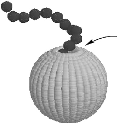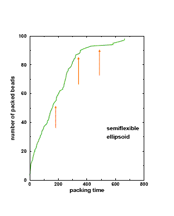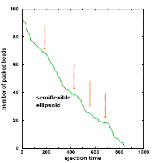Oxford Theoretical Physics
Condensed Matter Theory: Soft and Biological Matter
Julia Yeomans
Research:
Vacancies:
Group Members:
- Scott Edwards
- Nuno Silvestre
- Gareth Alexander
- Halim Kusumaatmaja
- Matthew Blow
- Richard Matthews
- Victor Putz
- Yiannis Zacharoudiou
- Anton Markesteijn
Collaborators:
- Anna Balazs
- Issam Ali
- Davide Marenduzzo
- Enzo Orlandini
- Olivier Pierre-Louis
Links:
- Oxford University
- Oxford Physics
- Theoretical Physics
- Condensed Matter Theory
- Theory of Soft and Biological Matter
Lecture Courses:
Back to current research interest
EJECTION OF DNA FROM VIRAL CAPSIDS
Bacteriophages comprise DNA, the genome, packaged inside a rigid container, the phage capsid. In order to reproduce itself a bacteriophage must inject a cell with its DNA. A simple way of doing this used by many viruses, for example λ-phage and Φ29, is to exploit the enormous pressure built up because of the strong confinement of the DNA within the capsid. In the λ-phage, for example, a genome of length 16 microns is packed into a spherical capsid with diameter 58 nm leading to a pressure of tens of atmospheres.
We are investigating the ejection by treating the DNA as a model polymer that is driven from the capsid by the energetic and entropic penalty of close confinement. Simulations are allowing us to study the interplay between equilibrium thermodynamics and non equilibrium effects due to the crowding and tangling of the confined DNA. Current work is focussing on the role of knotting on the ejection process, and on whether chemical chaperones outside the capsid can facilitate ejection.

|
Left: molecular motor, which packs the DNA; ejection is driven by pressure Right: turnip yellow mosaic virus |

|

|
Packing and ejection rates showing clear pauses due to crowding at the exit |

|
Recent Publications:
1. Polymer packaging and ejection in viral capsids: Shape matters, Phys. Rev. Lett. 96, 208102 (2006) [arxiv]
2. Ejection Dynamics of Polymeric Chains from Viral Capsids: Effect of Solvent Quality, Biophys. J. 94, 4159 (2008)
